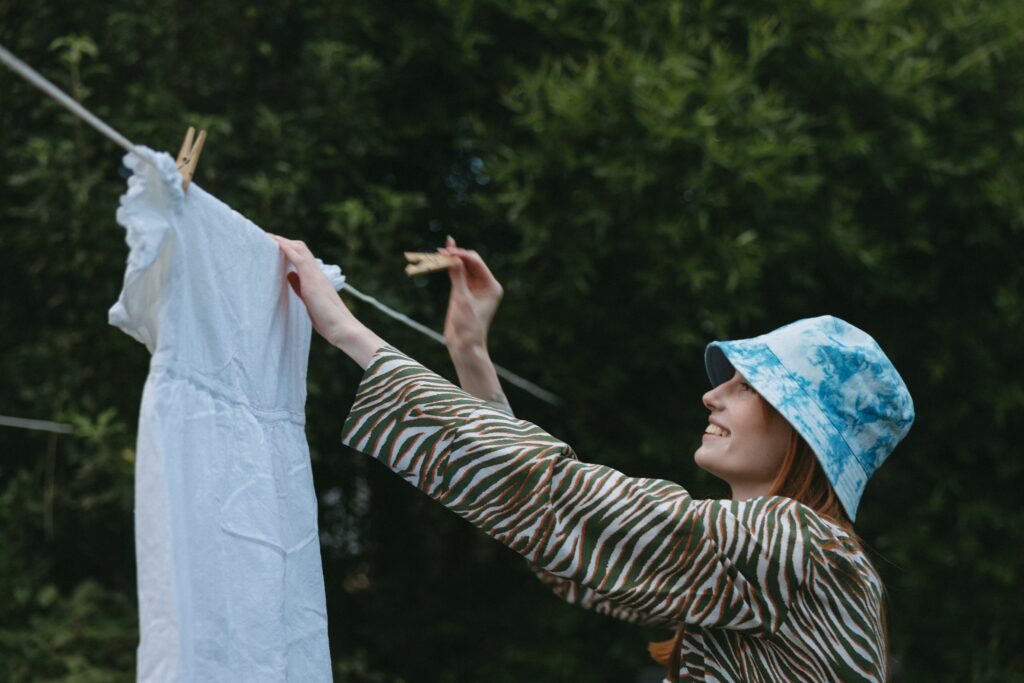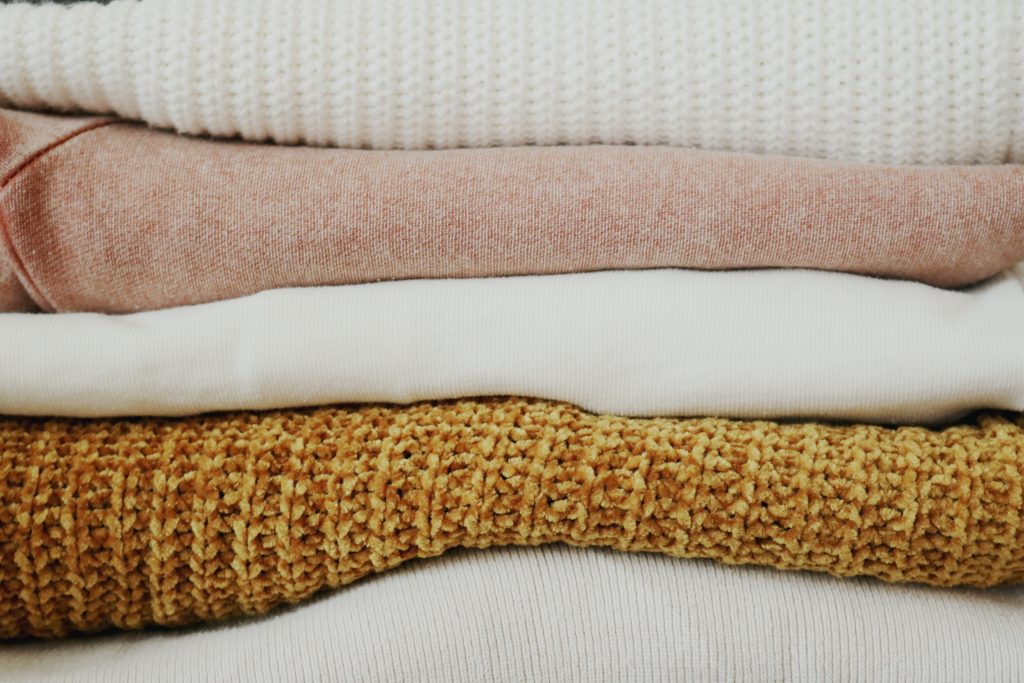Week Four
Fashion Forward
1. Caring for Your Clothes
You should be very proud of yourself, investing your valuable time (and money) in evolving your style. In addition to the exercises in this program, you’ve also started your investment in a high-quality, long-lasting wardrobe. Let’s not let that investment go to waste.
Following a week of shopping you are undoubtedly feeling enthusiastic about the potential of all of your new purchases. You don’t want that excitement to just be another phase in the Style Struggle Cycle; this time your enthusiasm is meant to last.
You’ve learned techniques for building new creative looks, as well as how to draw inspiration from others. In this segment you’ll learn how to maintain a beautiful wardrobe and ensure you are always looking truly Refined. Here we will teach you how to properly care for and maintain your clothing so you can protect your investment for for years to come.
“Buy less. Choose well. Make it last. Quality, not quantity. Everybody's buying far too many clothes.”
-Vivienne Westwood
Laundering

Clothing care is extremely important, however it is a detail in your style development that is often overlooked. So often we get sloppy when it comes to how we clean and care for our garments. As a result, our once-gorgeous styles lose their color, feel, and shape.
No one wants to wear a sweater with excessive pilling, or that’s been faded and stretched in the wash. If you find your colors dull, your buttons falling off, or you’ve been the victim of a shrunken sweater scenario, you understand.
Here you’ll learn proper techniques for cleaning your new wardrobe, and keeping all your garments looking fresh and new.
When to Wash
There’s no question: the number one way to increase the life and look of your clothing is to wash less. We’ve been conditioned to wash our clothes after every wear, and this is completely unnecessary. Running your clothes through the laundry is rough on fabrics, and dry cleaning uses harsh chemicals that break down clothing fibers over time. Don’t get me wrong, we don’t want your fabulous style to be overshadowed by the smell of body odor. However Refined’s general rule (with a few exceptions) is to attempt three wears before you wash. Think that sounds impossible? Here are some tips to help you launder less.


Spot Clean
This is by far one of the easiest ways to avoid the washing machine. Carry a stain removal pen or wipes with you at all times. When a mess happens, clean it right away to avoid letting it settle into the fibers of your garment. Not able to spot clean straight away? No problem! As soon as possible apply a small amount of detergent to a cotton swab and gently scrub any stains to avoid a full wash cycle.

Layer Up
The biggest concern clients have is that their clothing is going to smell. Having a collection of breathable fitted undershirts and tank tops to layer under blouses and sweaters is an easy way to avoid your body's natural odors from absorbing into your clothes. By adding a protective, light-weight, base layer, you can eliminate most instances of odor transfer.

Add Vodka
If smells have transferred to your clothing, either from you or your environment, grab the vodka! Vodka kills odor causing bacteria, and is an easy way to remove odors from your clothing. Mix a 1:1 ratio of vodka and water into your steamer to eliminate smells and freshen fabrics. If you want to avoid applying heat to your garment, spritz vodka directly from a spray bottle (with a mist setting) onto your clothing.

Flip It
Before any of your clothing makes it's way into the washing machine, take the time to turn them inside out. This is particularly necessary for darker dyed garments, and especially the first time you wash. This can reduce fading and discoloration over time. It also reduces pilling and snags to the outside of your clothing. (You know, the part people see)

Avoid the Dryer
Most woven fabrics, and some knits are best left to air dry. Take your clothing out of the washer immediately after the cycle is complete then lay garments flat. Take your time and don't be sloppy with this step so that your styles keep their shape. Unless the care tag suggests, do not line dry your clothes. Gravity will cause the fabrics will stretch and lose shape over time.

Use a Delicates Bag
For undergarments, lace camisoles, and undershirts, reduce wear during washes by using a delicates bag. By washing your delicates in a mesh bag you reduce friction that creates wear and tear, as well as prevent losing these smaller items in the wash cycle.

Don't Overlaod
Friction is not a friend to your clothes. When your washing machine is overloaded, the friction between your clothes increases wear and tear. Instead do smaller loads of laundry. And don't feel guilty for wasting water; by washing your clothes less frequently you more than make up for this.

Reduce Detergent
Don't forget; smaller loads mean much less detergent. Most laundry soaps contain chemicals that can be damaging to your garments. Over time, detergents can alter color and break down fabrics. Use detergent sparingly to increase the life of your clothing. When possible, opt for nontoxic, scent-free laundry soaps.
Storage


Just as important as the cleaning of your clothes is proper storage. In week two of this program you learned how to organize your closet to make building your daily outfits easy. Next let’s talk step back into the closet to implement tips that will extend the life of your favorite garments.

Make Room
You’ve learned that friction is the enemy of your clothes. In the same way you don’t want to over-crowd your clothing in the wash, you also don’t want to cram your clothes into your closet.
In week two you learned about the SOSC method for organizing your closet. If you implemented this technique you may have moved your out-of-season pieces into storage to make room in your closet. Not only does this make your garments easy to access, but it also reduces friction and wear and tear on clothes.
Giving your clothing a little breathing room well also help to avoid wrinkling (and additional heat damage from over-ironing) as well as color fading or color transfer.


Out of Sight
Another thing to consider when you move your out-of-season garments into storage, is their new environment. You want ensure that your winter sweaters aren’t baking somewhere out of sight in the summer heat.
Keeping your seasonal clothing in a cool dry place in important to avoid exposure to mildew, mold, pests, bacteria, or other potential damaging environmental factors.
You also don’t want to over-stuff boxes and bags with your out-of-season garments. Instead, carefully fold and hang these items in a neat and organized way. You’ll be thankful for the extra effort when you pull these pieces out of storage.
Stay Organized
Choosing proper storage receptacles is another important factor in protecting your clothing. If possible, store out-of-season garments like jeans, sweaters, pants, and shoes in plastic storage bins. This style of storage maintains a tight seal, keeping moisture and bugs out. Plastic bins are easy to stack, and won’t put pressure or weight on your clothing. They also make it easy to see what’s inside.
For clothing that you want to keep hanging such as suits, formal dresses, and nice blouses, opt for cotton breathable garment bags. Garments bags protect your clothing with minimal friction. Add labels to keep everything organized and easy to access.

Maintenance
Throughout the lifetime of your clothing, you will undoubtedly run into some unexpected and unavoidable mishaps. You may spill, snag, stain, or tear something. The Refined philosophy on this is, “if it can be fixed, fix it.”
Having a plan, acting fast, and maintaining proper care protects the investment you’ve made in your clothing. Like taking your car in for an oil change, or going to the doctor for an annual checkup, regular maintenance and upkeep of your clothing increases its lifespan.
If you have garments on the chopping block, take a look at some of these tips to see if you can breathe new life into any of your old favorites.


Steam
Owning a steamer is a total game-changer for your clothing. In many instances a steamer makes an excellent replacement for your iron. It's an easy way to remove wrinkles from most fabrics. It is particularly useful on garments with pleats, beads, sequins, decorative details, and delicate fabrics. Don't put your wrinkled clean clothes in the closet: steam before you store. Having those garments ready-to-wear means you'll be more likely to grab it.

Iron
While a steamer is an excellent way to remove wrinkles, if you are dealing with heavier or more sturdy fabrics, the iron is best. Examples include trousers or dress slacks, as well as garments that look best with sharp edges and crisp creases. To preserve your clothing, pay attention to iron temperature. When it doubt, default to a lower than suggested temp. We know it's easy to put off ironing, but make the effort to iron clothes immediately after cleaning, so you aren't discouraged from wearing it later.

Starch
Starching is easily one of the most underrated styling tips. Everyone knows that starching leaves your clothes looking crisp, and reduces the likelihood of wrinkles. However there are many other benefits. Dirt and sweat are more likely to stick to starch instead of the fabric, making clothes easier to clean. It also allows you to go longer between washes. Spray starch before ironing then hang immediately. DO NOT starch your silk, wool, or cashmere.
Special Fabrics

Don’t forget, Refined’s Fabrics Guide is an excellent resource to reference when you are ready to clean your clothes. You can also refer to a garment’s care tag for accurate instructions. However, there are a few fabrics that require extra attention. Next we’ll talk about some extra measures you can take to maximize the life of your denim and leather style investments.
Denim

Wash Less
Aim to wash your jeans after about 10 wears. Denim is 100% cotton and while it is durable, every time you wash dyes fade. To maintain the look and feel for your jeans, wash as infrequently as you can.

On Cold
A cold water wash cycle can help maintain your jean's color. Even better, turn your denim inside out to reduce fading and color transfer.

Don't Dry
Because denim is 100% cotton, the dryer is the enemy. To avoid the shrinking and warping of the fabric, let your jeans dry flat.

Fold & Stack
While it may seem like a smart idea to hang your jeans, there is absolutely no need. All premium denim retailers recommend simply folding and stacking your jeans.
Leather & Suede

Cover
When not in use, store your leather goods in a protective dust bag. This helps prevent scratches and fading. Avoid using plastic as it prevents good ventilation.

Shape
Leather and suede can easily become stretched or misshapen. Use a shaper for shoes, and store handbags upright. Avoid over-stuffing your leather purses to help them keep their shape.

Condition
Leather conditioner or cream moisturizes your leather goods to prevent cracking. Apply conditioner every 6-12 months to keep your shoes and purses looking like new.

Avoid Heat
Store your leather goods away from a furnace vent, and out of direct sunlight. Excessive heat and light can result in shrinking and fading. Do not use heat to try to dry damp leather.
Additional Tips
Whether a garment is brand new, or an old favorite, there are ways you can take a little extra care to ensure your styles look their best. Take a look at some of these additional tips to learn how you can improve the look and feel of styles you love, with minimal effort.

Before your first wear...

Trim & Clip
Often times, in an effort to produce more pieces quickly, clothing manufacturers will cut corners in the production process. Particularly with less expensive clothing, you may find loose and hanging threads on your brand new garments. Before your first wear, take a minute to give your new purchase a once-over. Check the hem, sleeves, and edges for these threads and give them the chop. Not only could these small threads get caught and result in damage to the clothing, but those small bits of string make the garment look cheap. Taking time to remove these improves the overall look of the garment.

Protect
As you learned in week three, your footwear is one category of fashion where it's okay to splurge. In order to further your investment, before your shoes ever hit the pavement, it is important to take proper precautions to protect them. Weatherproofing spray is an easy way to avoid stains and other forms of damage that could happen to your shoes. Whether your shoes are leather, suede, or canvas, there are affordable weatherproofing sprays for each of these textiles. Taking time to spray your new shoes can give you many additional years of wear.
Reversing wear and tear...

Pilling
Knit garments are vulnerable to pilling. When it comes to soft or plush fabrics, friction over time can cause fibers to become matted or knotted resulting in what we know as pilling. You can slow pilling with proper cleaning and storage, but it some cases it is inevitable. When it happens, remove the small collections of fibers easily with a disposable razor. A razor quite literally shaves away these pills that have formed and will keep your clothing looking like new.

Holes and Tears
Don't let small holes be the death of your clothes. In many cases these things can be fixed with a quick stitch. Having a simple sewing kit on hand, even if you're not a seamstress, can allow you to keep those pieces a little longer. Fixing it right away will prevent the damage from growing or getting worse. When you don't feel confident mending a hole, or if a tear is a little larger than you're comfortable with, take the garment to a professional.

Find a Professional
Having a good relationship with the right professional can be the most useful tool in protecting the investment you make in your wardrobe. Everyone should have a local seamstress or tailor that they trust. Not only is it helpful having someone to alter your ill-fitting garments and to mend and repair, but a good seamstress can be helpful in breathing new life into clothes that don't get much wear.
summary